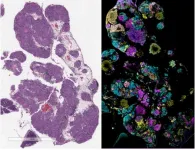(Press-News.org) Geneticists from Trinity College Dublin, together with an international team of researchers, have deciphered the prehistory of aurochs – the animals that were the focus of some of the most iconic early human art – by analysing 38 genomes harvested from bones dating across 50 millennia and stretching from Siberia to Britain.
The aurochs roamed in Europe, Asia and Africa for hundreds of thousands of years. Adorned as paintings on many a cave wall, their domestication to create cattle gave us a harnessed source of muscle, meat and milk. Such was the influence of this domestication that today their descendants make up a third of the world’s mammalian biomass.
Dr Conor Rossi, Trinity, first author of the article that has just been published in leading international journal Nature Communications, said: “The aurochs went extinct approximately 400 years ago, which left much of their evolutionary history a mystery. However, through the sequencing of ancient DNA, we have gained detailed insight into the diversity that once thrived in the wild as well as enhanced our understanding of domestic cattle.”
Although fossils of aurochs found in Europe date back 650,000 years ago, about the time archaic species of human appeared in the continent, animals from the east and west extremes of Eurasia share a much more recent common ancestry, pointing toward a replacement around 100,000 years ago, probably by migrations out of a southern Asian homeland.
In an echo of human prehistory, this replacement was not complete, with traces of earlier ancestry surviving in European aurochs.
Dr Mikkel Sinding, co-author and postdoctoral researcher in the Department of Biology, University of Copenhagen, said: “We normally think of the European aurochs as one common form or type, but our analyses suggest there were three distinct aurochs populations alone in Europe – a Western European, an Italian, and a Balkan. There was thus a greater diversity in the wild forms than we had ever imagined.”
Intriguingly, climate change also wrote its signature in aurochs genomes in two ways:
First, European and north Asian genomes separated and diverged at the beginning of the last ice age, around 100,000 years ago, and did not seem to mix until the world warmed up again at its end. And second, genome-estimated population sizes dropped in the glacial period, with a more pronounced hard time endured by European herds. These lost the most diversity when they retreated to separated refugia in southern parts of the continent before repopulating it again afterwards.
The most pronounced drop in genetic diversity occurs between the period when the aurochs of southwest Asia were domesticated in the north of the Fertile Crescent, just over 10,000 years ago, to give the first cattle. Remarkably only a handful of maternal lineages (as seen via mitochondrial DNA which is handed down via mothers to their offspring) come through this process into the cattle gene pool.
“Although Caesar exaggerated when he said it was like an elephant, the wild ox must have been a highly dangerous beast and this hints that its first capture and taming must have happened with only a very few animals,” said Dan Bradley, Professor in Trinity’s School of Genetics and Microbiology, who led the study.
“However, the narrow genetic base of the first cattle was augmented as they first travelled with their herders west, east and south. It is clear that there was early and pervasive mating with wild aurochs bulls, leaving a legacy of the four separate preglacial aurochs ancestries that persists among the domestic cattle of today.”
END
Ancient DNA brings to life history of the iconic aurochs, whose tale is intertwined with climate change and human culture
2024-10-30
ELSE PRESS RELEASES FROM THIS DATE:
Reversing environmental decline: Lessons from African communities
2024-10-30
In rural Africa, where livelihoods are often tied directly to the land, environmental degradation poses a critical threat to both ecosystems and people’s well-being. New research reveals ways to tackle the dual challenges of land degradation and poverty.
In rural Africa, where livelihoods are often tied directly to the land, environmental degradation poses a critical threat to both ecosystems and people’s well-being. A new study co-authored by researchers at Stanford University and the French Agricultural Research Centre for International Development (CIRAD) analyzes how ...
'Black box' of stem cell transplants opened in world-first blood study
2024-10-30
For the first time, scientists have tracked what happens to stem cells decades after a transplant, lifting the lid on the procedure that has been a medical mystery for over 50 years.
Insights could pave the way for new strategies in donor selection and transplant success, potentially leading to safer, more effective transplants.
Researchers from the Wellcome Sanger Institute and their collaborators at the University of Zurich were able to map the behaviour of stem cells in recipients’ bodies up to three decades post-transplant, ...
New pathway for sensing cold temperatures identified in rice
2024-10-30
A gene called COLD6 contributes to cold tolerance in rice, potentially offering a pathway to use molecular design to breed a rice variety with higher resistance to cold stress. This work appears October 30 in the Cell Press journal Molecular Cell.
“Cold damage is a major challenge in rice production, and identifying key gene modules in signalling pathways is a crucial step in addressing this issue,” says senior study author Kang Chong of the Chinese Academy of Sciences. “Our research focused on uncovering the molecular mechanism behind crops’ response to cold stress. We hope to ...
Study identifies how ovarian cancer protects itself, paves way for improved immunotherapy approach
2024-10-30
New York, NY [October 30, 2024]—Researchers at the Icahn School of Medicine at Mount Sinai have discovered a way that ovarian cancer tumors manipulate their environment to resist immunotherapy and identified a drug target that could overcome that resistance.
The study, published in the October 30 online issue of Cell [DOI: 10.1016/j.cell.2024.10.006], used a cutting-edge spatial genomics technology and preclinical animal models, with tumor specimens from ovarian cancer patients further validating the findings.
The researchers found that ovarian cancer cells produce a molecule called Interleukin-4 (IL-4), which is typically ...
State policies regulating law enforcement access to prescription drug monitoring program testosterone prescription data
2024-10-30
About The Study: This study found that testosterone prescription data through prescription drug monitoring programs was accessible to law enforcement without basic safeguards (such as a warrant or subpoena) in nearly half of states. The ease of access to this sensitive medical information raises privacy, care quality, and civil liberties concerns, especially amid the proliferation of gender-affirming care bans.
Corresponding Author: To contact the corresponding author, Katie McCreedy, MPH, email mccreedy.k@northeastern.edu.
To access the embargoed study: Visit our For The Media website at this link https://media.jamanetwork.com/
(doi:10.1001/jama.2024.20035)
Editor’s ...
Validation of the Kansas City Cardiomyopathy Questionnaire in patients with tricuspid regurgitation
2024-10-30
About The Study: In this cohort study, the Kansas City Cardiomyopathy Questionnaire (KCCQ) had strong psychometric properties in patients with severe tricuspid regurgitation, including reliability, responsiveness, and validity. These data support use of the KCCQ in patients with severe tricuspid regurgitation as a measure of their symptoms, function, and quality of life and also for assessing the impact of interventions, such as transcatheter tricuspid valve intervention, in rigorously controlled trials.
Corresponding Author: To contact the corresponding ...
New study shows combination therapy slows cognitive decline in at-risk populations
2024-10-30
An important new study led by the Centre for Addiction and Mental Health (CAMH), and with partnership across several Toronto Dementia Research Alliance (TDRA) sites— Baycrest, Sunnybrook Health Science Centre, Unity Health Toronto, and University Health Network— has demonstrated that a combination therapy can slow cognitive decline in older adults at risk for dementia.
The study was published today in JAMA Psychiatry: "Slowing cognitive decline in major depressive disorder and mild cognitive ...
Slowing cognitive decline in major depressive disorder and mild cognitive impairment
2024-10-30
About The Study: This study showed that cognitive remediation and transcranial direct current stimulation, both targeting the prefrontal cortex, is efficacious in slowing cognitive decline in older adults at risk of cognitive decline, particularly those with remitted major depressive disorder (with or without mild cognitive impairment) and in those at low genetic risk for Alzheimer disease.
Corresponding Author: To contact the corresponding authors, email Benoit H. Mulsant, MD, MS, (benoit.mulsant@utoronto.ca) and Tarek K. Rajji, MD, (tarek.rajji@utsouthwestern.edu)
To access the embargoed study: Visit our For The Media website at this link https://media.jamanetwork.com/
(10.1001/jamapsychiatry.2024.3241)
Editor’s ...
Autism diagnosis among US children and adults
2024-10-30
About The Study: In this cross-sectional study of children and adults in the U.S., autism spectrum disorder diagnosis rates increased substantially between 2011 and 2022, particularly among young adults, female children and adults, and children from some racial or ethnic minority groups. Diagnosis prevalence trends generated using health system data can inform the allocation of resources to meet the service needs of this growing, medically complex population.
Corresponding Author: To contact the corresponding author, Luke P. Grosvenor, PhD, email luke.p.grosvenor@kp.org.
To access the embargoed study: Visit our For The Media website at this link https://media.jamanetwork.com/
(doi:10.1001/jamanetworkopen.2024.42218)
Editor’s ...
Researchers identify “sweet spot” for safe surgery after heart attack
2024-10-30
After a heart attack, aging adults face double or triple the risk of life-threatening complications – like a debilitating stroke or another heart attack – when they move forward with elective noncardiac surgeries too soon, according to new University of Rochester research published in JAMA Surgery.
A deep dive into the Medicare database of 5.2 million surgeries from 2017 to 2020 for patients 67 and older suggests delaying surgery for three to six months following a heart attack, known as a non-ST-segmented elevation myocardial infarction (NSTEMI).
Researchers aim to identify the “sweet spot” for safely scheduling additional surgical procedures ...

